Generalized sweating episodes, occurring during the day or night (or both), are a common presenting symptom in primary care.
Excessive sweating, or generalized hyperhidrosis, is the secretion of excess sweat. It can be primary (idiopathic) or secondary (due to an underlying cause). When sweating is limited to specific body areas, it is called primary focal hyperhidrosis.
In the case of night sweats (sleep hyperhidrosis), they are episodes of generalized hyperhidrosis that occur during sleep and can range in severity from moderate diffuse sweating to drenched efforts that require changing nightwear and even sheets.
Causes
An overheated room or too many bed covers can simply cause increased night sweats.
Given the myriad possible causes of night sweats and the conditions that can present with symptoms of night sweats, the challenge is to correctly identify those patients with a severe underlying cause while minimizing unnecessary diagnostic testing.
Diagnosis
A detailed medical history is essential in evaluating a patient with generalized hyperhidrosis or night sweats. We must take into account:
- Characteristics: Exact details of sweating episodes are essential to clarify and include the severity and frequency of events. Light sweats are usually less of a concern for a serious underlying illness or infection than soggy night sweats that cause patients to change their nightwear and sheets. In addition, the frequency of work, including daytime symptoms, should be determined.
- Fever: Fever must be certainly excluded when evaluating a patient with night sweats. When a documented fever is present in association with night sweats, infection and malignancy become the most likely diagnostic possibilities.
- Constitutional symptoms: the presence of enlarged lymph nodes or known history of malignancy. We have to ask about unintentional weight loss, fatigue, and itching, which may suggest the presence of malignancy (such as lymphoma).
- Infections: tuberculosis, HIV, bacterial infections, and Covid infection are some of the conditions accompanied by night sweats.
- The geographical region of residence of the patient. We also ask about travel history. We ask about known or suspected mosquito or tick bites, etc.
- Hormonal status (estrogens and androgens) and endocrine etiology: age and menopausal status, use of estrogen-containing products, and recent obstetric history. Also, check for thyroid problems. Symptoms include heat intolerance, palpitations, tremors, flushing, diarrhea, wheezing, or headache.
- Medicines.
- Neurological history: We evaluate a history of spinal cord injury, stroke, or other neurological disorders that may be associated with autonomic dysreflexia.
Night sweats: Adult woman fanning suffering from heatstroke sitting in the living room at home
Clinic tests
Although the medical history is the cornerstone of the clinical evaluation of patients with night sweats, a focused physical examination can provide additional diagnostic information (general appearance, temperature, heart rate, blood pressure, and weight; enlarged lymph node chains; thrush). ; paleness, thyroid exam, etc.).
Our next step in the diagnostic approach to the patient with generalized hyperhidrosis or night sweats depends on the medical history and physical examination information. At no time during the evaluation did we treat with antibiotics empirically.
- We will carry out a more detailed study for patients with history and physical findings that suggest a specific etiology. For example, a CT or PET scan, a biopsy of an enlarged lymph node, an appropriate blood test, and a bone marrow biopsy should be performed if lymphoma is suspected.
- Patients with fever as the only finding on history and physical examination; if the history and physical examination do not suggest a specific etiology, but objective fever is documented, there is an increased likelihood of occult infection or malignancy.
- For patients without fever but with profuse, clammy sweats requiring bed linens to be changed, further evaluation is warranted; fever may be absent among some immunosuppressed patients despite cancer or systemic infection.
- At each step of the following evaluation, it is important to repeat a careful medical history, as New diagnostic symptoms often emerge over time:
- We carry out an initial evaluation to rule out possible infection with a complete blood test in which we request specific inflammatory parameters such as ESR.
- If these tests are regular and drenching night sweats persist, a computed tomography or positron emission tomography (PET) scan should be obtained to evaluate lymphoma, solid tumor, or abscess.
- If the above studies are usual and drenched night sweats persist, we perform a transthoracic echocardiogram as a screening test to evaluate for the presence of culture-negative endocarditis.
- If there is no obvious diagnosis at this stage of the evaluation and severe night sweats persist, further evaluation usually includes a bone marrow biopsy.
The differential diagnosis of generalized hyperhidrosis and night sweats includes infection (most commonly TB, HIV, and bacterial infections), malignancy (lymphomas and non-hematological malignancies such as prostate, kidney, thyroid cancer, etc.), medications (most often antidepressants, followed by antipsychotics, anticholinergics, oral antidiabetics, hormonal therapies, etc.), drugs (alcohol, methadone, opiates, etc.), endocrine causes (including estrogen and androgen deficiency, neuroendocrine, menopause, pheochromocytoma, hyperthyroidism, carcinoid syndrome, etc. .), neurological (autonomic dysreflexia, autonomic neuropathy) and other less common causes.
When should you go to the doctor?
We will schedule a visit with a doctor if the night sweats:
- They happen regularly.
- They interrupt your sleep.
- They are accompanied by fever, weight loss, localized pain, cough, diarrhea, or other symptoms that worry you.
- They appear after months or years in which the symptoms of menopause have been absent.







